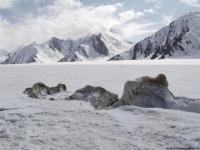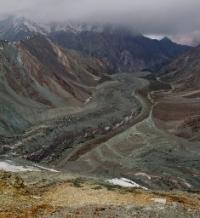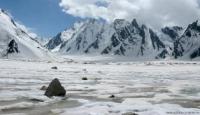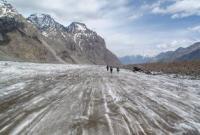You are here
Medvezhy Glacier.




Tajikistan section of the Silk Road.
“Not from a long life the mind ripens, but from frequent travels”
Dushanbe & Central Asia on Great Silk Road.
Medvezhy Glacier is located on the western slope of the ridge of the Academy of Sciences, in the basin of the Abdukagor River, a tributary of the Vanch River in the Murghab region of the Gorno-Badakhshan Autonomous Region of Tajikistan.
The length of the glacier is 15.8 kilometers, the area of the Medvezhy glacier is 25.3 square kilometers. It is a valley glacier with a wide flat pool food connecting in the crest of the ridge through a low ice section with the origins of the Academy of Sciences glacier, a tributary of the Fedchenko Glacier. A steep 900 meter icefall from this
basin in a deep gorge descends the narrow and long tongue of the Bear Glacier. This glacier is one of the most famous and well-studied pulsating glaciers not only in Tajikistan, but throughout the world. This glacier is characterized by rapid movements, as a result of which the glacial end moves for several months 2 kilometers down the valley and blocks the valley of the Abdukagor River, where the dammed lake is quickly filled up to 20 million cubic meters.
Breakouts of the lake occur through underground channels through the end of the Medvezhye glacier and cause destruction in the Vanj valley. Known progress glacier in 1916, 1937, 1951, 1963 and 1973. The last two were among the few movements of pulsating glaciers observed by glaciologists, and as a result of studies conducted on this glacier since 1963, the movement of the glacier in 1973 was predicted by us in advance, which allowed us to take measures in advance to protect the facilities from floods.
The research results on the Medvezhye glacier were published in the monograph “Pulsating Glaciers” (Dolgushin, Osipova. 1982). According to old-timers, the glacier came in 1916, 1937 and 1951, but the study of the Bear began only in the early sixties.
In the spring of 1963, the speed of the glacier suddenly increased one hundred times, it began to move at a speed of up to fifty meters per day. The surface of the glacier cracked, in the upper reaches it sagged, and in the lower part it rose up a hill.
On his way, he destroyed the village of Dalniy geologists and blocked the Abdukagor River with a high ice dam, resulting in a lake with a volume of about twenty million cubic meters. On June 18, 1963, water broke its way through an icy barrier, and mudflow flowed through the entire Vanch Valley at a rate of up to 2,000 cubic meters per second (the average flow rate of Vancha is 50 cubic meters in spring and 300 cubic meters per second).
To the measures taken in advance, victims and destruction were avoided. However, soon the ice tunnel closed, and the lake began to accumulate again. By the end of June, when 15 million cubic meters was accumulated, a second breakthrough occurred, which turned out to be weaker than the first. In total, in 1963, the Bear increased its length by 1700 meters, while its area increased by 1.1 square kilometers. The volume of ice delivered amounted to 140 million cubic meters.
By autumn, the glacier stopped. The Abdukagor River carried its waters through a tunnel in an ice dam. In the spring of 1973, a new offensive of the Bear Glacier began. By this time, not all the ice of the previous movement had melted, so new masses of ice moved in the previous year.
Again, an ice dam of half a kilometer wide and 150 meter high blocked the Abdukagor valley. The depth of the resulting lake reached 110 meters. On June 19, 1973, when 27 million cubic meters of water accumulated in the lake, a breakthrough occurred.
The maximum flow rate reached thousands of cubic meters per second. At the same time, the water level in the Vanch river in the Vanch district center rose by 3 meters for 90 kilometers from the glacier, in Kalai-Khumb for 180 kilometers from the Medvezhiy - by one and a half meters, in Termez - by half a meter.
When 3 million cubic meters remained in the lake, the tunnel collapsed, closed, the lake replenished, and on July 3 a second breakthrough occurred. However, measures taken in advance prevented casualties and destruction.
A new move of the Bear was expected in 1985, but contrary to the forecast, the glacier behaved calmly. Only in the fall of 1988 did its speed increase from 0.4 to 4.0 meters per day. This was a harbinger of progress.
During its ripple in 1989, the Medvezhy glacier extended by 1.2 kilometers, its area increased by 0.8 square kilometers, the volume of ice brought out was about 80 million cubic meters. However, the height and width of the ice dam turned out to be less than with previous movements, therefore, the dammed lake was smaller, and its breakthroughs occurred many times and had a relatively small size.
The filling of the lake began on June 16, 1989, and on the night of June 26 the first breakthrough occurred, although only 4 million cubic meters were accumulated in the lake. The water consumption during the breakthrough was only 60 meters per second.
The second breakthrough with a flow rate of more than 120 cubic meters per second occurred on the night of June 28. Such villages passed along Wanch without causing any harm. The lake reached its maximum volume (6.1 million cubic meters) on June 5, but with a breakthrough, the flow rate did not exceed 50 - 60 cubic meters per second.
By mid-July, glacier movement had virtually ceased, and a permanent tunnel formed in the ice dam. The last ripple of the Bear Glacier occurred in the summer of 2001. At the same time, the glacier was extended by 450 - 600 meters, made 9.6 million meters of cubic ice.
In April, it moved 5 meters per day, in May its speed reached 40 meters per day, but by the end of June the glacier had almost stopped - its speed was 0.1 - 0.15 meters per day. He did not reach the Abdukagor River only 250 meters, so no lake appeared.
Until now, the reason for his movements has not been precisely clarified, so it is difficult to answer why, during the last movement, Medvezhy did not reach the river, did not form a lake. It is possible that this is to some extent related to climate warming. In this regard, it is necessary to conduct its further study.
Authority:
"Glaciers." L.D. Dolgushin, G.B. Osipova. Series "Nature of the world." Moscow, the publishing house "Thought". 1989. "Glaciers of Tajikistan." General Directorate for Hydrometeorology and Environmental Monitoring of the Ministry of Nature Protection. Dushanbe, 2003.







